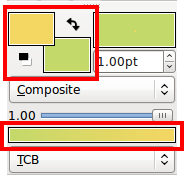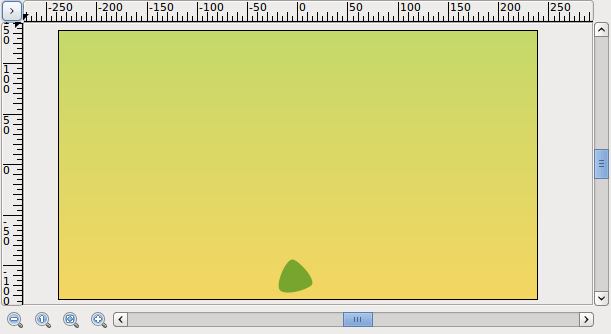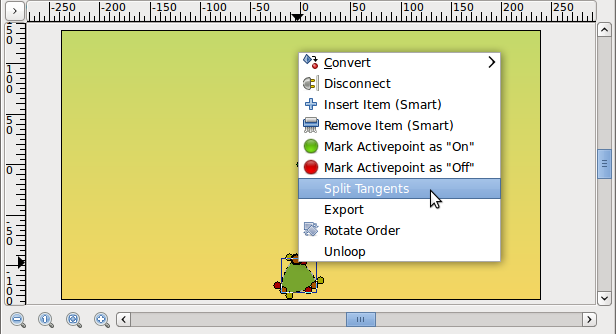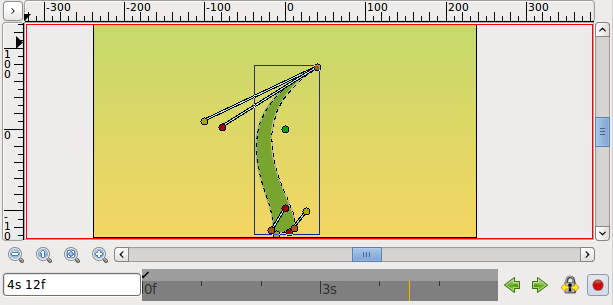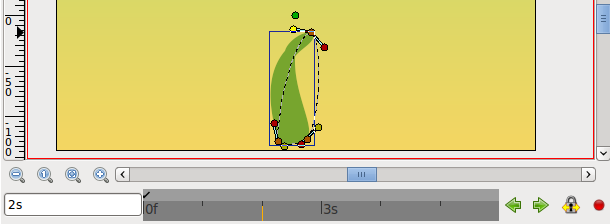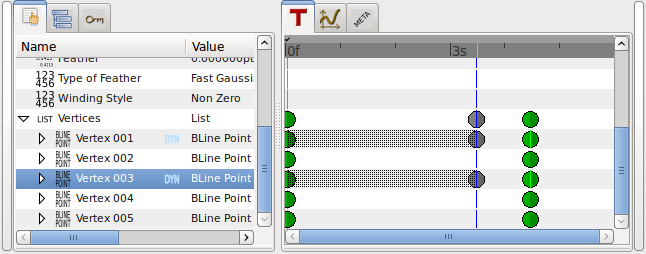Flower Animation
(Not a manual page) |
("Basic settings" & "Animate the stem" sections updated) |
||
| Line 1: | Line 1: | ||
<!-- Page info --> | <!-- Page info --> | ||
{{Title|Flower Animation}} | {{Title|Flower Animation}} | ||
| − | {{Category | + | {{Navigation|Category:Manual}} |
| − | + | [[Category:Tutorials]] | |
| + | [[Category:Tutorials Intermediate]] | ||
<!-- Page info end --> | <!-- Page info end --> | ||
| − | + | == Basic settings == | |
| + | In this tutorial we will learn how to create a simple animation of a growing flower using blines. | ||
| + | [[Image:flower_0.png|right|frame]] Start Synfig Studio - a new animation will be created. If you already have Synfig Studio started, select {{c|File|New}} in the toolbox. | ||
| − | + | First, we need to create a gradient for a background. Click on the outline and fill colors in the toolbox to select a colors our gradient will have. You can also directly edit the gradient by clicking the gradient line in the toolbox. | |
| − | |||
| − | |||
| − | |||
| − | |||
Select the Gradient Tool and drag your cursor vertically across the canvas to fill it with the gradient. | Select the Gradient Tool and drag your cursor vertically across the canvas to fill it with the gradient. | ||
| − | + | Next, select the Bline Tool and in the Tool Options Panel, make sure that only {{Literal|Create Regiion BLine}} is checked. In the toolbox, set the fill color to green. Draw a kind of triangle with the Bline tool. To close the shape after drawing the 3 vertices, right click on the first vertex and choose {{Literal|Loop Bline}}. | |
| − | + | ||
| − | + | ||
| − | + | Now that the shape is closed, you can "create" the bline shape by selecting another tool or pressing a button with gear-like icon at the bottom of the Tool Options Panel. | |
| − | This will be the base of the stem. You can tweak the tangent handles (red dots) a bit to make a rounder triangle. With the {{l|Normal Tool}}, right-click on each vertex and select | + | [[Image:FlowerTutorialCanvas1.png|center|frame]] |
| + | |||
| + | This will be the base of the stem. You can tweak the tangent handles (red dots) a bit to make a rounder triangle. With the {{l|Normal Tool}}, right-click on each vertex and select {{Literal|Split Tangents}}, so the tangent handles of each vertex can be moved separately. | ||
We're done with the basic settings. | We're done with the basic settings. | ||
| − | |||
| − | + | [[Image:FlowerTutorialCanvas2.png|center|frame]] | |
== Animate the stem == | == Animate the stem == | ||
| − | + | In the Canvas Menu, select {{c|Edit|Properties}}. Go to the Time tab, set the {{Literal|End time}} to {{Literal|6s}} and click OK button. | |
| − | In the Canvas Menu, select | + | |
| − | + | ||
| − | Click at the beginning of the timetrack ( | + | Click at the beginning of the timetrack ({{Literal|0f}}), then, on the {{l|Keyframes Panel}} (the one with a key icon) click button with a "+" icon (add a new keyframe). |
{{l|Keyframe|Keyframes}} allow us to ''settle down'' the scene; i.e. on a keyframe, every element of the scene will have all its properties remembered. | {{l|Keyframe|Keyframes}} allow us to ''settle down'' the scene; i.e. on a keyframe, every element of the scene will have all its properties remembered. | ||
| − | Click again on the timetrack, at | + | Click again on the timetrack, at {{Literal|4.5s}}. |
| − | Press the green circle at the bottom right of the canvas (or whatever icon you have there, depending on your icon theme) | + | Press the green circle at the bottom right of the canvas (or whatever icon you have there, depending on your icon theme) to switch to the {{l|Animate Editing Mode}} (the circle is now red). |
With the {{l|Normal Tool}}, select the green sprout, and move the upper vertex up to make a stem. | With the {{l|Normal Tool}}, select the green sprout, and move the upper vertex up to make a stem. | ||
You can play with the vertex handles to bend the shape a bit if you want. | You can play with the vertex handles to bend the shape a bit if you want. | ||
| − | + | [[Image:FlowerTutorialCanvas3.png|center|frame]] | |
| − | While you are still at | + | While you are still at {{Literal|4.5s}}, right-click on the stem border, close to the top, and choose {{Literal|Insert Item (smart)}}. Do the same on the other side of the stem. Right click on those new points and choose {{Literal|Split Tangents}} again. Then try to make a shape that looks like the one on the image, to create the flower bud. |
| − | + | [[Image:FlowerTutorialCanvas4.png|center|frame]] | |
| − | Now if you click on | + | Now if you click on {{Literal|2s}} (for example), you'll see that the shape of the bud is slightly visible, even if the sprout is rather small, and even if the bud ducks are invisible. |
| − | + | [[Image:FlowerTutorialCanvas5.png|center|frame]] | |
| − | + | Let's say we want the bud to appear only at 3.5s, and be full size at 4.5s. | |
| − | + | Click on {{Literal|3.5s}} on the timetrack. Now take a look at the {{Literal|{{l|Params Panel|Params}}}} and {{Literal|{{l|Timetrack Panel|Timetrack}}}} panels at the bottom. You'll see that each parameter in the Params Panel matches a row in the Timetrack Panel. The last parameter is the vertices list. Click on the small arrow on the left to unfold the list. You should see something like this: | |
| − | The | + | |
| − | + | [[Image:FlowerTutorialTimetrackParamsPanels6.png|center|frame]] | |
| − | For example if you click on | + | Each big green dot (or {{l|waypoints|waypoint}}) stands for a recorded value (here the vertices positions were recorded at 0f with the keyframe, and at 4s when we moved some vertices or vertices handles). The two vertices we added to make the bud are marked at {{Literal|DYN}} (dynamic). Right-click on them in the params list, and select "Mark Activepoint as Off". |
| + | |||
| + | The panel should now look like this, the grayed part being the part where the bud vertices have no effect on the stem. | ||
| + | |||
| + | [[Image:FlowerTutorial-7-WaypointsActivepointsOff.png|center|frame]] | ||
| + | |||
| + | For example if you click on {{Literal|2s}} or even {{Literal|3s}} now, the bud shape is not visible. It starts to appear only a little after 3.5s. | ||
However, the shape of the stem may not look very nice during its growth between 0 and 4s. Make sure you're still in Animate Edit Mode, and tweak the shape at various moments in time, to get something you like. | However, the shape of the stem may not look very nice during its growth between 0 and 4s. Make sure you're still in Animate Edit Mode, and tweak the shape at various moments in time, to get something you like. | ||
The animation of the stem is now finished, but it still lacks the petals. | The animation of the stem is now finished, but it still lacks the petals. | ||
| − | You can watch a preview of your animation: Go to | + | You can watch a preview of your animation: Go to {{c|File|Preview}}, validate, wait for the preview to be generated, and watch. |
| + | |||
| + | {{Note|Note|Previews are often pixelated and blurry, but the final render will be clean-cut. Higher quality previews are obtainable by using higher values for 'Zoom' and 'Frames per second' in the preview dialog window.}} | ||
== Adding the petals == | == Adding the petals == | ||
| Line 84: | Line 87: | ||
Now that there's a link between the petal and the top of the stem, when the top of the stem moves, the petal will follow the move. (And if the green duck of the petal move, the top of the stem will move, but we don't want to do that here.) | Now that there's a link between the petal and the top of the stem, when the top of the stem moves, the petal will follow the move. (And if the green duck of the petal move, the top of the stem will move, but we don't want to do that here.) | ||
| − | On the {{l|Layers Panel}}, select the newly created Petal layer and duplicate it (with the third button, on the bottom of the | + | On the {{l|Layers Panel}}, select the newly created Petal layer and duplicate it (with the third button, on the bottom of the panel). On the canvas, press Ctrl+A to select all the vertices of the duplicated petal, and move them a little, so the petals are no longer overlaid (''Don't move the green duck, just the orange ones''). Repeat the process several time, to get something looking like this image. |
http://i209.photobucket.com/albums/bb207/rore4wiki/Synfig/flower_9.png | http://i209.photobucket.com/albums/bb207/rore4wiki/Synfig/flower_9.png | ||
Revision as of 12:46, 8 May 2010
Basic settings
In this tutorial we will learn how to create a simple animation of a growing flower using blines.
Start Synfig Studio - a new animation will be created. If you already have Synfig Studio started, select "File → New" in the toolbox.First, we need to create a gradient for a background. Click on the outline and fill colors in the toolbox to select a colors our gradient will have. You can also directly edit the gradient by clicking the gradient line in the toolbox.
Select the Gradient Tool and drag your cursor vertically across the canvas to fill it with the gradient.
Next, select the Bline Tool and in the Tool Options Panel, make sure that only "Create Regiion BLine" is checked. In the toolbox, set the fill color to green. Draw a kind of triangle with the Bline tool. To close the shape after drawing the 3 vertices, right click on the first vertex and choose "Loop Bline".
Now that the shape is closed, you can "create" the bline shape by selecting another tool or pressing a button with gear-like icon at the bottom of the Tool Options Panel.
This will be the base of the stem. You can tweak the tangent handles (red dots) a bit to make a rounder triangle. With the Normal Tool, right-click on each vertex and select "Split Tangents", so the tangent handles of each vertex can be moved separately. We're done with the basic settings.
Animate the stem
In the Canvas Menu, select "Edit → Properties". Go to the Time tab, set the "End time" to "6s" and click OK button.
Click at the beginning of the timetrack ("0f"), then, on the Keyframes Panel (the one with a key icon) click button with a "+" icon (add a new keyframe). Keyframes allow us to settle down the scene; i.e. on a keyframe, every element of the scene will have all its properties remembered. Click again on the timetrack, at "4.5s". Press the green circle at the bottom right of the canvas (or whatever icon you have there, depending on your icon theme) to switch to the Animate Editing Mode (the circle is now red).
With the Normal Tool, select the green sprout, and move the upper vertex up to make a stem. You can play with the vertex handles to bend the shape a bit if you want.
While you are still at "4.5s", right-click on the stem border, close to the top, and choose "Insert Item (smart)". Do the same on the other side of the stem. Right click on those new points and choose "Split Tangents" again. Then try to make a shape that looks like the one on the image, to create the flower bud.
Now if you click on "2s" (for example), you'll see that the shape of the bud is slightly visible, even if the sprout is rather small, and even if the bud ducks are invisible.
Let's say we want the bud to appear only at 3.5s, and be full size at 4.5s.
Click on "3.5s" on the timetrack. Now take a look at the "Params" and "Timetrack" panels at the bottom. You'll see that each parameter in the Params Panel matches a row in the Timetrack Panel. The last parameter is the vertices list. Click on the small arrow on the left to unfold the list. You should see something like this:
Each big green dot (or waypoint) stands for a recorded value (here the vertices positions were recorded at 0f with the keyframe, and at 4s when we moved some vertices or vertices handles). The two vertices we added to make the bud are marked at "DYN" (dynamic). Right-click on them in the params list, and select "Mark Activepoint as Off".
The panel should now look like this, the grayed part being the part where the bud vertices have no effect on the stem.
For example if you click on "2s" or even "3s" now, the bud shape is not visible. It starts to appear only a little after 3.5s.
However, the shape of the stem may not look very nice during its growth between 0 and 4s. Make sure you're still in Animate Edit Mode, and tweak the shape at various moments in time, to get something you like.
The animation of the stem is now finished, but it still lacks the petals. You can watch a preview of your animation: Go to "File → Preview", validate, wait for the preview to be generated, and watch.
|
Note Previews are often pixelated and blurry, but the final render will be clean-cut. Higher quality previews are obtainable by using higher values for 'Zoom' and 'Frames per second' in the preview dialog window.
|
Adding the petals
You can now leave the Animate Editing Mode by clicking on the red circle at the right bottom of the canvas.
Change the paint color to pink, and create a petal with the bline tool. You'll notice that the green Duck that allows easy movement of a shape is at the center of the canvas. Select all the vertices of the petal with Ctrl+A and move them close to the green duck (with the Normal Tool), as shown.
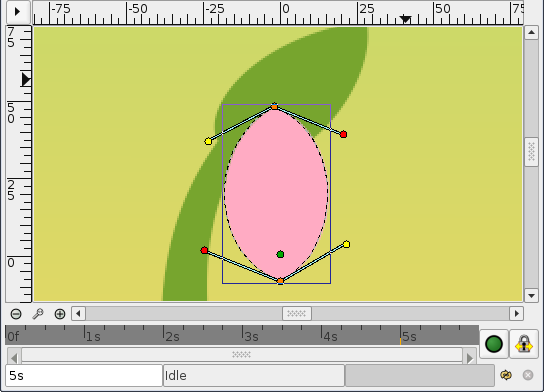
Then drag the green duck very close to the top of the bud. Tweak a bit the petal if needed. Also, in the Layers Panel select the petal layer and put it under the stem layer. Click on the petal to select it, then Ctrl-Click on the stem. Both objects should be selected.
Now click on the vertex at the top of the stem and ctrl-click on the green duck of the petal (both should appear in a lighter color, as they are selected). Then right-click on the stem top vertex, and select "link". The petal will move a bit as the green duck is snapped on the stem vertex.
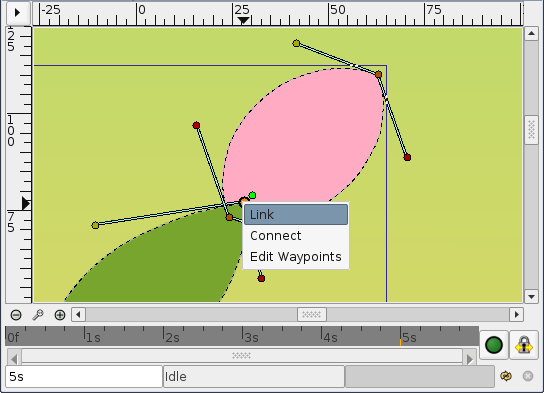
Now that there's a link between the petal and the top of the stem, when the top of the stem moves, the petal will follow the move. (And if the green duck of the petal move, the top of the stem will move, but we don't want to do that here.)
On the Layers Panel, select the newly created Petal layer and duplicate it (with the third button, on the bottom of the panel). On the canvas, press Ctrl+A to select all the vertices of the duplicated petal, and move them a little, so the petals are no longer overlaid (Don't move the green duck, just the orange ones). Repeat the process several time, to get something looking like this image.
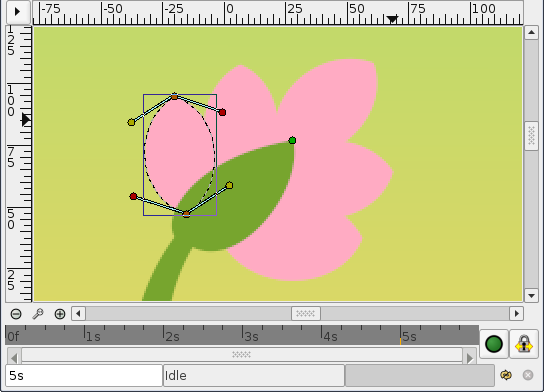
Note that the duplicated petals are also linked to the stem.
If you go back to the first keyframe, you'll see that the petals are visible.
We don't want that. We want the petals to appear and bloom almost at the end of the growth.
Hiding the petals
- This part is maybe the most clumsy one. I guess there may be an easier way to manage this step, and if I find it, I'll update the tutorial ;)
Let's say we want the petals to appear a little after 4 seconds in the animation, and be full size at 5 seconds, instead of being visible and full size all the time.
Switch to Animate Edit Mode again by clicking on the green circle at the bottom right of the canvas.
On the timetrack, click to place the cursor at 5 seconds.
On the Keyframes Panel, click on "+" to add a new keyframe. As the flower won't move between 5 and 6 seconds, adding a keyframe at 5s makes sure that the changes we will make won't affect the next frames.
Now click on 4s, and on the Layers Panel, select all the petals layers (with Ctrl+click), then press Ctrl+A to select all the petals vertices. Scale them down with the Scale Tool, and move them, so they are hidden by the stem, as shown.
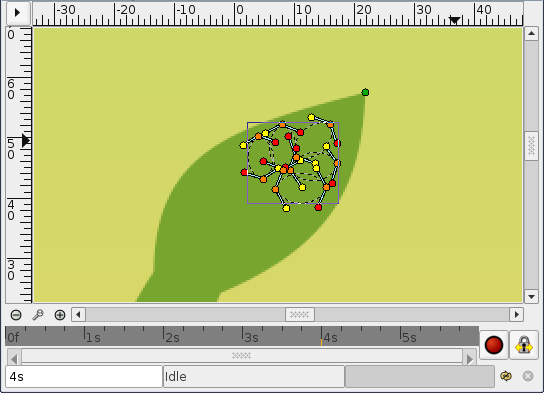
From 4s to 5s, the petals will now appear and bloom. But the problem is that they are still visible from the first keyframe to the 4s keyframe.
We could either change the size of the petals an make them tiny and hidden on every frame from 0s to 4s, or we could make them invisible on those frames.
Let's choose the second solution. To make things easier, we are going to Encapsulate the petal layers in an Inline Canvas. With all the petal layers selected, right-click on them on the Layers Panel and select Encapsulate. You can rename the layers to make things more understandable.
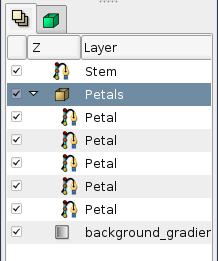
Select the "Petals" inline canvas and jump to the first keyframe. In the Param tabs, set the Amount value to 0. The petals are now invisible on that keyframe.
Note that two waypoints were added in front of the "Amount" parameter, one at 0s and the other at 5s. Drag the 5s waypoint to 4s, so that the opacity of the petals is at 1 at 4s.

There is still one problem left : From 0s to 4s, the opacity of the petals slowly increases, making the petals visible when they shouldn't. To solve this, we will change the Amount interpolation method: Right click on the Amount waypoint at 0f, and select Edit waypoint. A new dialog will appear, in which you can choose the In and Out interpolation. Set the Out Interpolation to Constant. This means that after that waypoint, the Amount value will remain constant, until another waypoint is encountered. So from 0f to 4s the Amount value will be equal to 0, and at 4s it will suddenly changed to 1, and make the petals visible, as expected. Alternatively, we could have achieved the same effect by setting the In Interpolation of the waypoint at 4s to Constant.
Notice how (half of) the waypoint changes from a green circle (meaning smooth animation of the amount parameter) to a red step (meaning that the amount parameter is suddenly stepped).

Now you're done. The stem grows for 4.5 seconds and then stays still the last 1.5 second. The petals are hidden until 4 seconds, and then grow quickly between 4 and 5 seconds, and stay still the last 1.5 second too.
Click on File > Render to render your animation. Select any format you want, and don't forget to uncheck the "Use current frame" option (otherwise, one frame only will be rendered).
